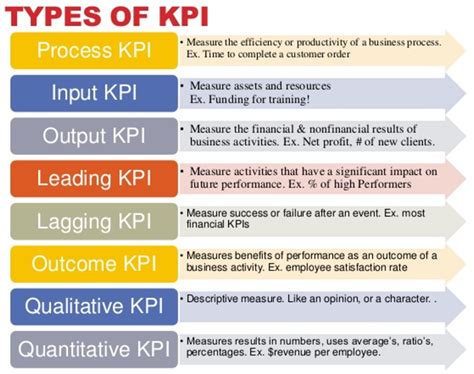Tracking Key Performance Metrics: 4 Types, Examples

Welcome to our guide on tracking key performance metrics. In today’s competitive business landscape, it is crucial for organizations to measure and analyze their performance to stay ahead of the game. By tracking key performance metrics, businesses can gain valuable insights into their operations, identify areas for improvement, and make data-driven decisions. In this guide, we will explore the four types of key performance metrics and provide examples to help you get started.
1. Financial Metrics
Financial metrics are essential for evaluating the financial health and profitability of a business. These metrics provide insights into revenue generation, cost management, and overall financial performance. Some examples of financial metrics include:
- Revenue growth rate
- Net profit margin
- Return on investment (ROI)
- Debt-to-equity ratio
- Cash flow
2. Customer Metrics
Customer metrics focus on measuring and analyzing customer behavior, satisfaction, and loyalty. These metrics help businesses understand their customers’ needs, preferences, and overall satisfaction with their products or services. Some examples of customer metrics include:
- Customer satisfaction score (CSAT)
- Net Promoter Score (NPS)
- Customer lifetime value (CLV)
- Customer churn rate
- Customer acquisition cost (CAC)
3. Operational Metrics
Operational metrics assess the efficiency and effectiveness of an organization’s operations. These metrics provide insights into key processes, productivity, and resource utilization. Some examples of operational metrics include:
- Cycle time
- First-time fix rate
- Inventory turnover
- Employee productivity
- Quality index
4. Marketing Metrics
Marketing metrics evaluate the performance and effectiveness of marketing campaigns and strategies. These metrics help businesses measure the return on investment (ROI) of their marketing efforts and optimize their marketing activities. Some examples of marketing metrics include:
- Conversion rate
- Click-through rate (CTR)
- Cost per lead (CPL)
- Return on ad spend (ROAS)
- Website traffic
Conclusion
Tracking key performance metrics is essential for businesses to measure their performance, identify areas for improvement, and make data-driven decisions. By monitoring financial, customer, operational, and marketing metrics, organizations can gain valuable insights into their operations and take proactive steps to drive growth and success.
Frequently Asked Questions
Q: Why is it important to track key performance metrics?
A: Tracking key performance metrics allows businesses to measure their performance, identify areas for improvement, and make data-driven decisions. It provides valuable insights into the organization’s operations and helps drive growth and success.
Q: How often should key performance metrics be tracked?
A: The frequency of tracking key performance metrics depends on the specific needs and goals of the business. Some organizations track metrics on a daily or weekly basis, while others may track them monthly or quarterly. It is important to establish a regular cadence of tracking to ensure timely insights and actionable data.
Q: What are some tools or software to track key performance metrics?
A: There are several tools and software available to track key performance metrics. Some popular options include Google Analytics, Salesforce, HubSpot, and Tableau. These tools offer comprehensive analytics and reporting capabilities to help businesses track and analyze their performance metrics.
Q: How can businesses use key performance metrics to improve their operations?
A: By tracking key performance metrics, businesses can identify areas for improvement and take proactive steps to optimize their operations. For example, if the customer churn rate is high, businesses can focus on improving customer satisfaction and loyalty initiatives. Similarly, if the inventory turnover is low, businesses can implement strategies to optimize inventory management and reduce holding costs.
Q: Can key performance metrics vary across different industries?
A: Yes, key performance metrics can vary across different industries and businesses. Each industry has its own unique set of performance indicators based on the nature of their operations and goals. It is important for businesses to identify and track metrics that align with their industry benchmarks and objectives.
